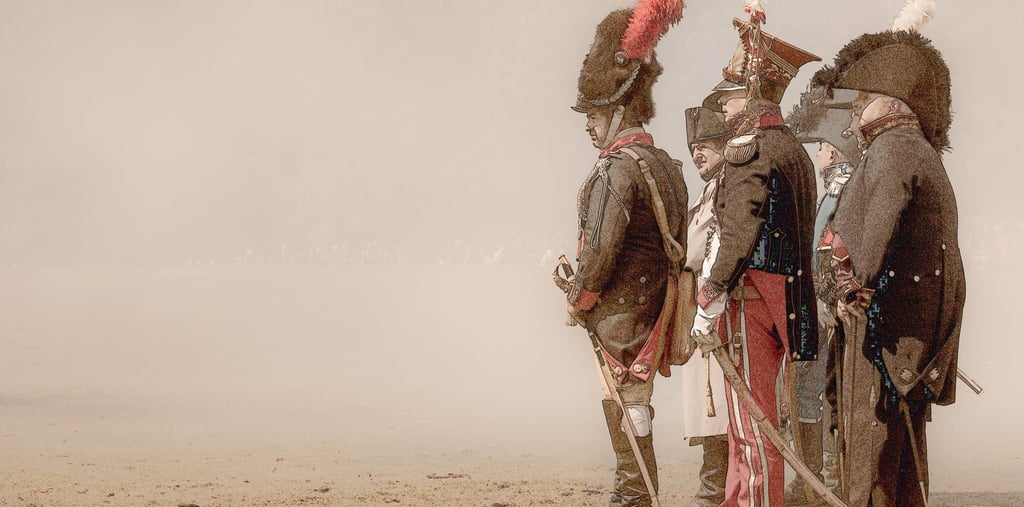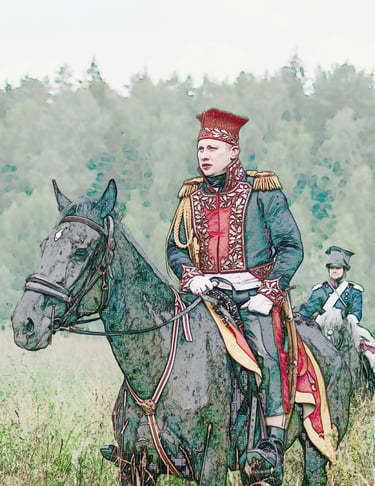Playing historical war games should allow you to feel the pain and stress of uncertainty that military leaders would have to go through in combat. A key aspect of enhancing the authenticity and complexity of a wargame is the 'Fog of War' principle, which I like to couple with the ‘Friction of War’. Murphy’s Law if you will. This principle highlights the limited data and intelligence available to commanders amidst combat, necessitating players to consider and act based on partial information. and the unexpected.
Without the factor of uncertainty tabletop games become bland, unchallenging and at times rather predictable results. It’s like other things in life, watch a game of rugby or football and note how many things go wrong by sheer accident, intent, weather conditions, outside interference, the referee, mood, attitude, the unexpected. Watch how the game can change if a key player is sent off or injured by an unexpected circumstance. A team can train all they like but no-one can predict an outcome with certainty.
The subject has been a perennial topic of discussion ever since I can remember and I could if inclined write an essay on the subject but I will hold myself in check. From my own perspective, I have learned that simplicity works best when addressing rules in this area, the alternative can often slow down a game.
However, let's have a brief look at a few key areas we should be considering, along with some suggestions I have collected over the years from other gamers.
1. Hidden Units and Visibility
Visibility is by line of sight. Hills, woods, high walls, hedges, dead ground, gulleys, intervening troops, and BUA’s block line of sight—thus, units on either side of a hill cannot see each other but would most likely be aware of each other if within a certain distance from the crest. Crest lines keep cropping up in games. You can’t see me; yes, I can...’cos. If units are both on a hill and within a certain distance, say 8 inches, they are aware of each other.
A sketch map to scale, gridded to match the table, e.g., a 12ft x 6ft table scales to 12ins x 8ins. Draw the terrain, but pencil in hidden commands and individual units. One can place a surreptitious bit of terrain to physically mark the position on the table as a backup if desired. Hidden movement is scaled in the same manner; just use a ruler to measure the distance on the sketch map. Hidden units stay hidden until they are discovered by scouts, adcs, or skirmishers, and units come within a certain distance, e.g., at a long musketry range, or they open fire.
Now, when a unit is discovered for whatever reason by an advancing enemy, I prefer not to put the figures out but instead some cotton wool smoke marker to indicate firing or place a marker indicating the type of unit, infantry, cavalry, or artillery. A marker could be as plain as you like, but I quite like the idea of a rectangular base with a touch of terrain and a couple of figures from my spares box—it looks better and keeps the enemy guessing as to who they are exactly. Ignore this paragraph at your leisure; it’s only an idea.
A commander looking down from high ground or a tall building can perhaps be allowed to see further than the predetermined visibility range. More importantly he may be able to see enemy formations that would normally be hidden in dead ground behind trees and buildings.
Many wargame rules cater to this. GdA have a simple method of determining dead ground behind obstructions. My own simple method is to measure from general or unit to the obstacle and then halve the result. Anything within that measurement is hidden, anything beyond that is seen, provided it is within the range of visibility of course.
2. Reconnaissance Missions
Finding the hidden enemy invites reconnaissance missions into the gameplay as an order or action. These missions can be assigned to specific units or conducted by the army’s available light troops. Implement a system where the level of information about hidden units varies. Some units might be fully concealed, while others are partially visible, providing players with clues about enemy positions.
The information gained from these missions can help players make more informed decisions and uncover hidden enemy units. Keeping to my rule of simplicity, a dice throw with a short modifier chart suffices for the results of the reconnaissance. Such a chart could have modifiers for a). the quality of the scouts and b). whether the enemy has screened or posted vedettes, etc. The result could mean the enemy is discovered and revealed (troops placed on the table) or is discovered but not fully revealed (place a marker; see above); it could also result in being driven off.
One final thought on scouting and advancing units is the discovery of hidden terrain features in the form of anything that doesn’t stick upwards from the ground, such as a ditch, ravine, marsh, bog, pond, small stream, perhaps even a small footbridge or ford. These can make a huge difference to a cavalry charge across open ground crashing into a ditch that was previously unseen. The 23rd Light Dragoons at Talavera comes to mind. As a unit advances a throw of the dice may result in an unseen obstacle which is then placed on table. The type of obstacle again decided by dice throw. When attempting to cross an unknown stream or small river, throwing a dice determines whether it is crossable at a that point.
3. Weather and Terrain Factors. Nature’s own Murphy’s Law
The role of weather and its effect on visibility is paramount in creating a truly immersive and dynamic gaming landscape. Here are some crucial aspects to keep in mind to capture the profound influence of weather conditions on your wargame experience:
How far can you see in the rain, fog, or snow? Years ago, I made a weather chart sheet based on the one found in the Revolution and Empires Rules and used it quite frequently when creating a scenario. Imagine fighting a game like Eylau in 1807, where an untimely snowstorm assisted the disaster that befell Augereau’s Corps. God help Napoleon if Davout’s glasses had steamed up, but that would be a ‘Random Event’.
Take into account the nature of the terrain. The unique interplay between different weather conditions and various terrains can lead to fascinating outcomes. Picture this: a deluge of rain could turn dusty trails into slippery mud paths, significantly impacting your troops' movement and sightlines.
The time of the day is no less significant. Early dawn or late dusk could shroud the field in semi-darkness, while a bright midday sun can illuminate the battlefield, providing clear visibility.
A variety of weather elements, such as rain, snow, mist, and storms, should also be factored in, each uniquely influencing visibility and the precision of long-range weaponry.
Don't underestimate the power of the wind. Its direction and force can affect the spread of smoke, the accuracy of missile attacks, and even the propagation of fire. Set a visibility range, keeping in mind that a foggy day may limit your sight to shorter distances, while clear weather could grant you a farther field of view.
Delve into research on how weather conditions influenced major battles during specific historical periods, and weave those insights into your gameplay. But remember, while realism is important, maintaining a balance with playability is key to ensuring an enjoyable gaming session.
Lastly, let the weather conditions shape your scenario objectives. Adjust victory conditions and challenges in accordance with the weather, providing a layer of complexity and realism. Offering adjustable rules gives players the flexibility to customise their game, catering to individual preferences and boosting overall engagement.
4. Random Events or Murphy’s Law
Revolution and Empire, rules created by The Emperor’s Press covering the Napoleonic era, have a chart of random events for Leader Fate. GaPå rules for the period 1700–1739 have a Randon Events table. I mention these two specifically because I have played both sets and found these charts fun, uncomplicated, and easy to use. Why not make your own set and let your creativity loose?
Whilst I’m on the subject, why not make movement more random. Unless on a parade ground or flat unimpeded terrain, troops would and could not march at a consistent pace. In the AWI rules British Grenadier by Partizan Press they have a simple dice throw dice throw modified by troop quality. It is simple and effective and keeps you guessing whether your move will actually get to an objective before your opponent.
5. Command and Control Limitations
Incorporating command and control limitations into your game can add another layer of realism. This can be done by imposing restrictions on the range or speed of orders or by introducing the possibility of miscommunication or delays. Personally, I find this aspect essential. Are my commanders Excellent, Good, Indifferent, Cautious, Aggressive. Is my CinC well or suffering from a cold or has his wife just left him (could be a minus or a plus)? When delivering orders, how far away is the recipient, will the courier even arrive? There is a lot to consider.
Most half-decent rules incorporate some methodology that simulates command and control at varying levels of complexity. Examples of this are found in General d'Armee, GdB, GaPå, Valmy to Waterloo and Revolution and Empire. There are more examples of course, depending on what ‘floats your particular boat’.
6. Make it Part of the Scenario
Designing specific scenarios that incorporate the ‘unknown’ can provide a unique and immersive gameplay experience. These scenarios can include objectives that are hidden or unknown to the players at the start of the game or special rules that simulate specific historical events or conditions. This allows players to step into the shoes of historical commanders and experience the challenges they faced, e.g. random events appropriate to the scenario, such as bad weather and political interference.
Conclusion
For me, there have never been rules that fully satisfy my expectations. But even my expectations have changed over the years. What I want from a game and even why I wargame may differ from other wargamers and the search for the Holy Grail of rules never ends. Rule writing isn’t easy and every set of rules has its very own mechanics and flavour, but if you don’t like the flavour but like the mechanics change it to suit you. Add to and adapt the rules is my approach and I love the extra flavour of uncertainty that can and should be imbued into a set of rules. Just saying.



